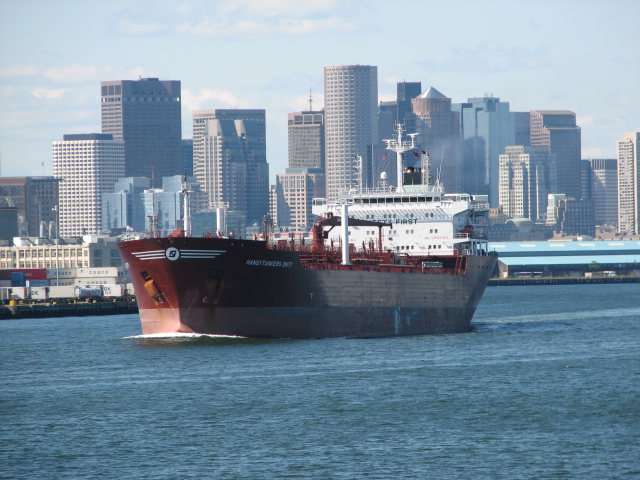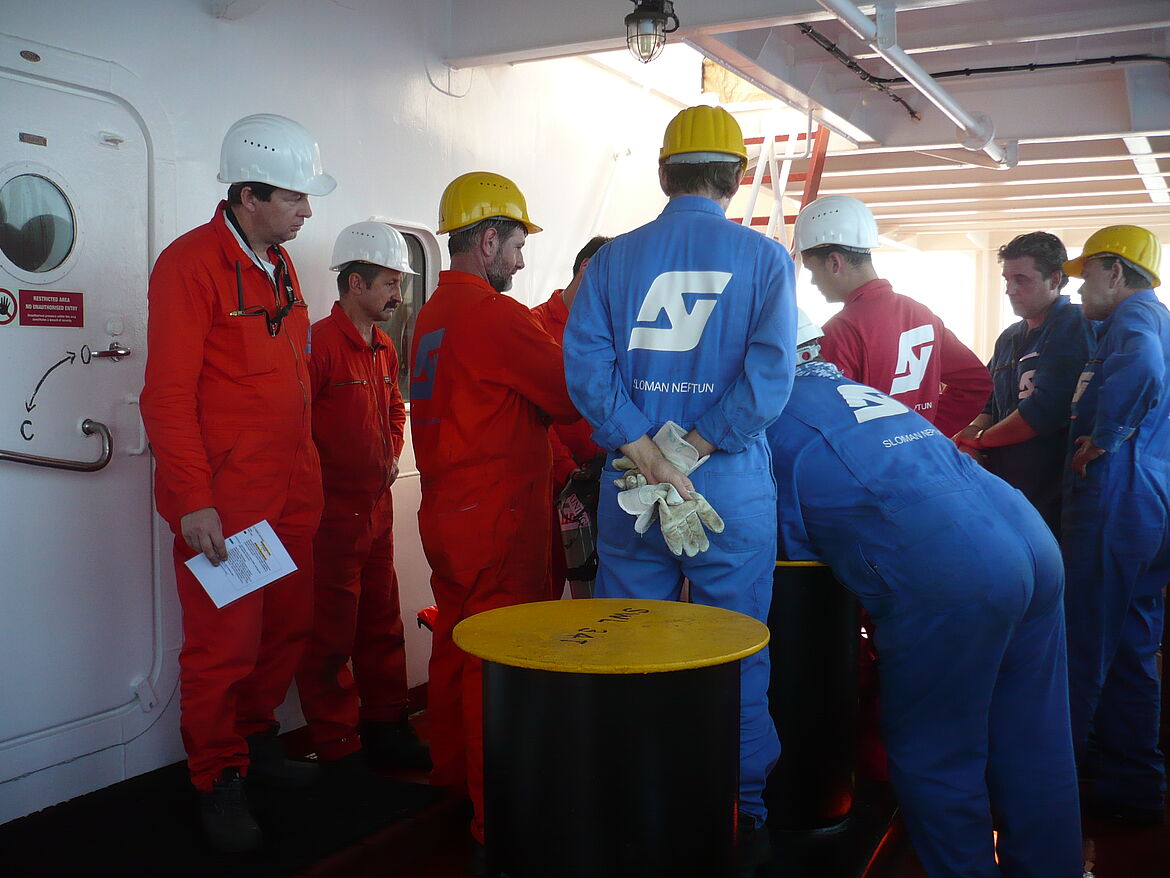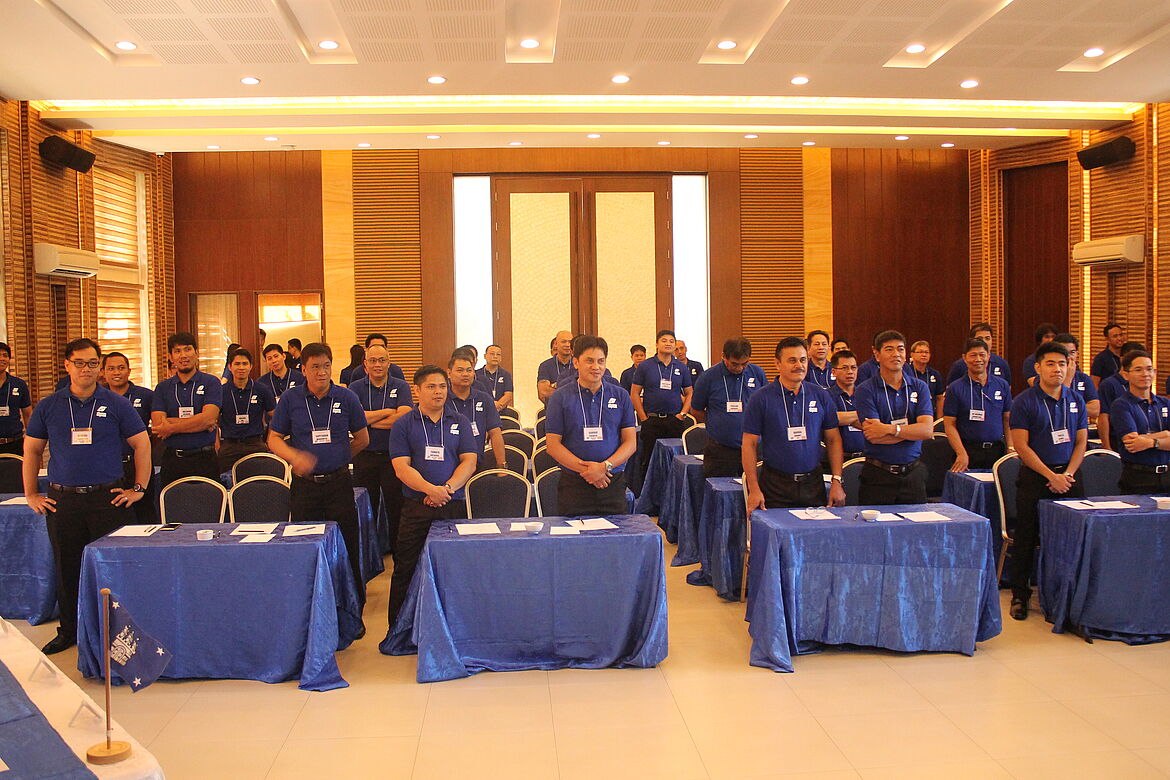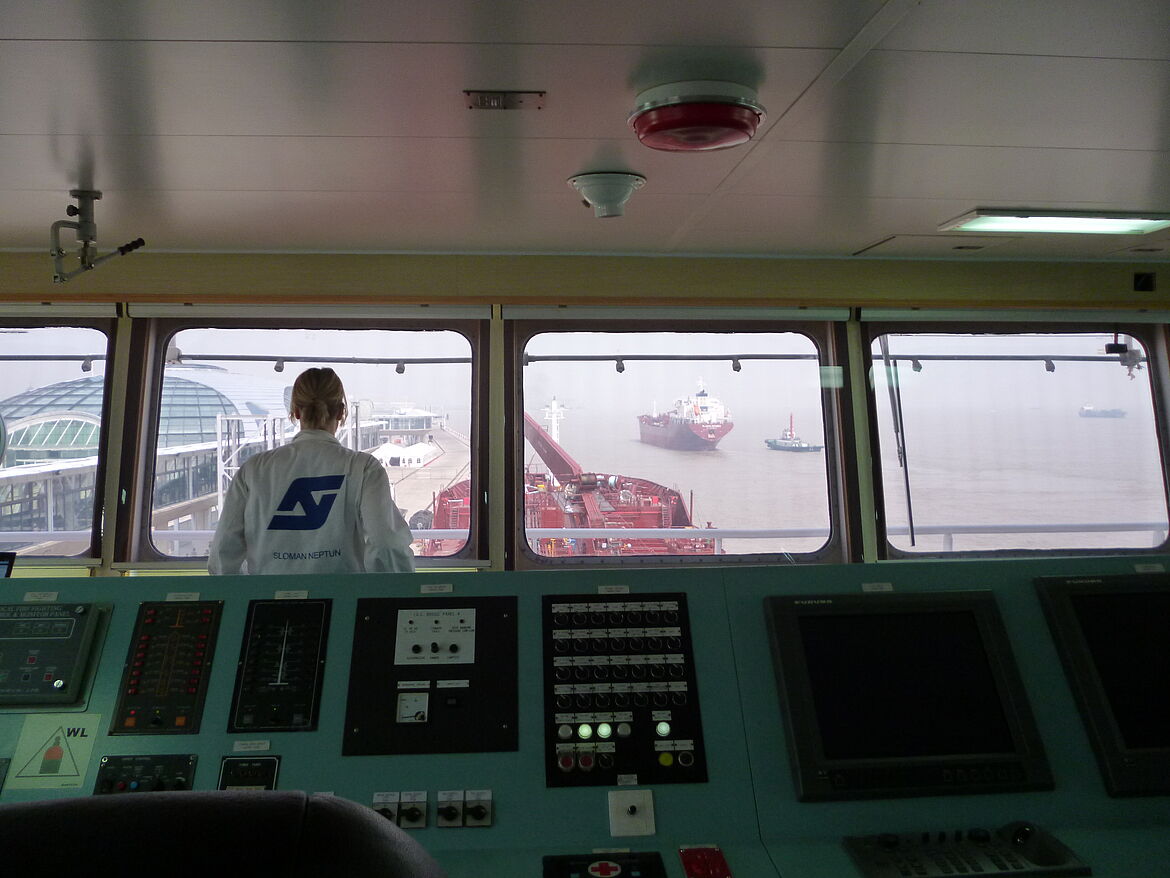

In shipping since 1873, SLOMAN NEPTUN's history goes back to the early days of steamships. It was at that time that a joint stock company under the name of Dampfschifffahrts-Gesellschaft "Neptun" Actien-Gesellschaft, Bremen, was established to operate a regular liner service between the river Weser and other North European ports. In the next decades this scope was extended to the Iberian Peninsula and West Mediterranean, including serving most ports along the way.
In 1969, and as joint venture with close shipping partners, the company co-founded, and became a shareholder of the UNIGAS Consortium and thereby – aside from its traditional liner activity – started operating gas tankers. At that time, the carriage of Liquid Petroleum Gas (LPG) by sea was still a segment in its early days.
On its 100th Anniversary in 1973, the company operated a diversified fleet, which included liner ships, gas tankers and research vessels. It was at this stage when the befriended SLOMAN GROUP of Hamburg, family owned and in shipping since 1793, acquired the majority of the shares and in addition merged in its fleet and related shipping activities. The company was consequently renamed.
Until the end of the century, SLOMAN NEPTUN continued its expansion into the tanker segment. The UNIGAS consortium, with its offices in Rotterdam, Houston and Hong Kong, developed to be the backbone of the company’s gas tanker activities. The liner service established itself in connecting Northern Europe with North Africa and other Mediterranean ports through regular sailings.
In the early 2000’s, the company started to further diversify its tanker activities by entering the Product Tanker, as well as Chemical Tanker segment.
Today, SLOMAN NEPTUN operates a diversified fleet of gas tankers, oil/chemical tankers and dry cargo vessels. We consider ourselves to be a wholistic ship owning company with all relevant management tasks such as technical, human resources, QHSE and commercial management being performed by in-house departments.
In addition to ship owning and operating, SLOMAN NEPTUN, through affiliated companies, is engaged in various other shipping related fields.

SLOMAN NEPTUN provides quality assured and customer oriented maritime services. We create mutual advantages to the satisfaction of all interested parties resulting, in an increase of long-term values for our business partners and shareholders.
Our business policies focus on five areas:
We are committed to respect the rules of law, conduct our business with integrity and manage our financial performance by:
SLOMAN NEPTUN strives for Quality, Health, Safety and Environment (QHSE) excellence in order to comply with the highest standards as required by ourselves, our partners and customers. We are certified by DNVGL for ISM, ISPS, MLC as well as ISO 9001 and ISO 14001. We are participating in all of our industry’s as well as customers' inspection programs to maintain and improve our QHSE performance.
Our goals:

As a quality, and service-oriented company, our long-term success is based above all on sustainable relationships with our business partners and employees, as well as the environment.
Sustainability is an essential element of our Quality, Health, Safety and Environment Management System (QHSE), which is part of the certification by DNV according to ISO 9001 (quality management) and ISO 14001 (environmental management). SLOMAN NEPTUN’s sustainability strategy has been developed in line with the requirements laid down in the German Sustainability Code (DNK), the Global Reporting Initiative Sustainability Reporting Standard (GRI SRS) and United Nations’ Sustainable Development Goals (SDG). Our sustainability strategy complies with the German Sustainability Code and is published on the DNK’s database.The certification covers our onshore activities and all ships. We are committed to offering our customers:
Our aim is to make the transport of materials and goods across the sea as safe and environmentally- friendly as possible. For many decades, we have regarded sustainable action as the basis of our past and future success. Since 2019, the focus has been on minimizing emissions; in particular to reducing our CO2 output.
We use the results of annual audits to continuously question ourselves and improve our sustainability processes.
SLOMAN NEPTUN is committed to the health and safety of its employees (no accidents, no incidents) by providing and maintaining healthy and safe conditions in the working environment and in accommodation spaces.
Continuous improvement in 'Environmental Protection Awareness and Excellence' throughout the entire life cycle of a vessel shall be a fundamental management objective of SLOMAN NEPTUN.
To achieve the intended outcomes, and to achieve continuous improvement SLOMAN NEPTUN has determined risks and responsibilities which are related to environmental aspects, compliance obligations and other issues or needs and expectations of our stakeholders.
SLOMAN NEPTUN continuously makes all employees aware of their own responsibility and influence to cause a significant environmental impact.
All operational key characteristics that have been identified to have significant environmental impact are measured and monitored. Especially fuel consumption, lubrication oil consumption and garbage quantity are annually reported.
The top management at least annually reviews the SLOMAN NEPTUN management system regarding, but not limited to, the company’s environmental performance, changing circumstances, developments in legal and other third-party regulations related to its sustainable aspects, including the review of risks and opportunities as well as the fulfilment of its existing compliance obligations.
The sustainability activities of SLOMAN NEPTUN are focused on:
It is the policy of SLOMAN NEPTUN to ensure that its ships are operated to comply with all necessary requirements to protect the environment in compliance with the existing International Conventions, Flag and Port State regulations, and Quality and Environmental ISO standards (ISO 9001,14001).
In the area of sustainability, we strive not only to meet the current regulations, but also those that are readily foreseeable from the International Maritime Organization (IMO), the European Union, the Flag and Port states, as well as the relevant industry standards of our customers.
SLOMAN NEPTUN’s sustainability strategy, related activities, targets and KPIs are laid down in a comprehensive report, available for all interested parties in German and English language. In case of interest, you are welcome to download the complete report.

| SLOMAN NEPTUN Schiffahrt-Aktiengesellschaft Nachhaltigkeitsbericht 2022 | Download (PDF) |
| Anhang 1 - Übersicht der Ziele und KPIs | Download (PDF) |
| Anhang 2 - Nachhaltigkeitserwartungen der Stakeholder | Download (PDF) |
| Anhang 3 - Umweltleistungsdaten – wesentliche Verbräuche | Download (PDF) |
| Anhang 4 - Umweltleistungsdaten – signifikante Emissionen | Download (PDF) |
| Anhang 5 - Soziale Leistungsdaten Bord- und Land-Personal | Download (PDF) |
| Anhang 6 - Index der DNK Kriterien, GRI SRS Indikatoren und der UN SDG Ziele | Download (PDF) |
| Sustainability Report 2022 English complete | Download (PDF) |
SLOMAN NEPTUN is a medium-sized Shipping Company which on regular basis offers interesting activities, duties and responsibilities on board our fleet and in our head office in Bremen. We aim to serve as a trusted employer for employees both ashore as well as onboard. Working for us means being part of a global community, where we truly believe in living our values.
The company fosters an atmosphere of respect and responsible behavior (‘just culture’) among all employees ashore and onboard with regard to the daily interaction with each other. An active safety culture is encouraged throughout the company by all employees from top to bottom, ashore or at sea.
We welcome Trainees who would like to apply under the German apprenticeship scheme („Ausbildung zum Schifffahrtskaufmann/-frau“).
In general the company aims for a stimulating working environment in which diversity is valued and encouraged. Find out more about us, and join us, to help create and develop the future of SLOMAN NEPTUN.
Please forward your application documents to:
SLOMAN NEPTUN Schiffahrt-Aktiengesellschaft
Human Resources Department or Crewing Department
Langenstr. 44
28195 Bremen
Germany
Or simply send your application papers by e-mail (max. 5 MB) to
Jobs ashore : career(at)sloman-neptun.com
Jobs at sea : hr-marine(at)sloman-neptun.com
Currently no vacancies.


| Vessel's Name | Capacity / CBM | Type DEG. C | IMO/USCG | Built | Type | DWT | GRT/NRT | LOA/LBP | Breadth | Draft | Speed | Quantity(Cargo Tank) | Capacity(Cargo Tank) | |||
|---|---|---|---|---|---|---|---|---|---|---|---|---|---|---|---|---|
| Deltagas | 12.057 | SP/FR -104 | 6.10 / 3.90 | 2013 | Ethylene-Carrier | 15.210 t | 12.819 / 3.846 | 142.54 / 134.45 | 21.60 | 12.10 | abt. 15.5 knts | 3 | 12057.1 | |||
| Epsilongas | 5.658 | SP/FR - 104 | 6.5 / 3.8 | 2000 | Ethylene-Carrier | 6.175 t | 5.278 / 1.583 | 107,86 m / 101,26 m | 16,80m | 6,50 m | abt. 15,5 knts | 2 | 5.658 m³ | |||
| Etagas | 12.057 | SP/FR -104 | 6.10 / 3.90 | 2014 | Ethylene-Carrier | 15016 | 12743 / 3823 | 143.01 / 134.46 | 21.60 | 12.10 | abt. 15.5 knts | 3 | 12057.1 | |||
| Kappagas | 5.643 | SP/FR - 104 | 6.5 / 3.8 | 2001 | Ethylene-Carrier | 6.211 t | 5.278 / 1.583 | 107,86 m / 101,26 m | 16,80 m | 6,50 m | abt. 15,4 knts | 2 | 5.643 m³ | |||
| Mygas | 12.355 | SP/FR -104 | 5.0 / 3.6 | 2017 | Ethylene-Carrier | 15.135 t | 13.549 / 4.065 | 146,00 m / 137,80 m | 22,60 m | 9,30 m | abt. 16,0 knts | 3 + Deck Tank | 12.355 m³ | |||
| Rhogas | 6.929 | SP/FR - 104 | 5.5 / 3.7 | 2012 | Ethylene-Carrier | 8.615 t | 8.009 / 2.403 | 113,00 m / 106,28 m | 19,20 m | 8,46 m | abt. 15,5 knts | 2 + Deck Tank | 6.896 m³ | |||
| Taugas | 12.364 | SP/FR - 104 | 5.0 / 3.6 | 2015 | Ethylene-Carrier | 15.134 t | 13.549 / 4.065 | 146,20 m / 138,79 m | 22,60 m | 9,31 m | abt. 16,0 knts | 3 + Deck Tank | 12.364 m³ | |||
| Thetagas | 9.164 | SP/FR - 104 | 5.5 / 3.95 | 2008 | Ethylene-Carrier | 10.263 t | 9.110 / 2.734 | 120,40 m / 112,58 m | 19,80 m | 8,53 m | abt. 16 knts | 2 | 9.107 m³ | |||
| Zetagas | 6.906 | SP/FR - 104 | 5.5 / 3.7 | 2013 | Ethylene-Carrier | 8.639 t | 8.009 / 2.403 | 113,00 m / 106,28 m | 19,20 m | 8,45 m | abt. 15,5 knts | 2 + Deck Tank | 6.906 m³ |
| Vessel's Name | DWT | CBM | Built | Type | GRT/NRT | LOA/LBP | Breadth | Draft | Speed | Quantity(Cargo Tank) | Capacity(Cargo Tank) | |||
|---|---|---|---|---|---|---|---|---|---|---|---|---|---|---|
| Sloman Hebe | 16.432 | 19.616 | 2019 | Oil/Chemical Tanker | 11.361 / 4.961 | 145,15 m / 135,60 m | 23,00 m | 8,80 m | abt. 13 knts | 14 | 19.616 m³ | |||
| Sloman Hera | 16.426 | 19.524 | 2012 | Oil/Chemical Carrier | 11.298 / 4.962 | 144,00 m / 136.35 m | 23,00 m | 8,80 m | abt. 13 knts | 14 | 19.524 m³ | |||
| Sloman Herakles | 16.417 | 19.528 | 2012 | Oil/Chemical Carrier | 11.298 / 4.962 | 145,15 m / 135,60 m | 23,00 m | 8,80 m | abt. 13 knts | 14 | 19.528 m³ | |||
| Sloman Hermes | 16.418 | 19.552 | 2012 | Oil/Chemical Carrier | 11.311 / 4.962 | 144,00 m / 136.35 m | 23,00 m | 8,80 m | abt. 13 knts | 14 | 19.552 m³ | |||
| Sloman Hestia | 16.371 | 19.616 | 2017 | Oil/Chemical Carrier | 11.361 / 4.961 | 145,15 m / 135,60 m | 23,00 m | 8,80 m | abt. 13 knts | 14 | 19.616 m³ | |||
| Sloman Themis | 35.000 | 38.000 | 2006 | Product Oil Tanker | 22.184 / 9.434 | 171,22 m / 161,99 m | 27,42 m | 11,80 m | abt. 15,5 knts | 14 | 38.839 m³ | |||
| Sloman Thetis | 35.000 | 38.000 | 2006 | Product Oil Tanker | 22.184 / 9.434 | 171,22 m / 161,99 m | 27,42 m | 11,80 m | abt. 15,5 knts | 14 | 38.839 m³ |
| Vessel's Name | Type | Built | DWT | Capacity | GRT/NRT | LOA/LBP | Breadth | Draft | Speed | Holds | Cranes | TEU+FEU | FEU+TEU | Homo. (14t) | Reefer | |||
|---|---|---|---|---|---|---|---|---|---|---|---|---|---|---|---|---|---|---|
| Sloman Discharger | MPP-Carrier | 2011 | 12.914 t | 16.230 m3 | 9.530 / 4.398 | 138,06 m / 130,00 m | 21,00 m | 8,06 m | abt. 14 knts | 2 | 2 cranes, SWL 80 t each combinable to 160 t | 771 | 338 + 89 | 546 TEU | 50 TEU | |||
| Sloman Discoverer | MPP-Carrier | 2012 | 12.594 t | 15.953 m3 | 9.611 / 4.260 | 138,01 m / 130,71 m | 21,00 m | 8,00 m | abt. 15 knts | 3 | 2 cranes, SWL 150 t each combinable up to 300 t | 665 + 264 | 290 + 85 | 524 TEU | 25 sockets – 25 reefers; max. 50 reefers via splitters | |||
| Sloman Dispatcher | MPP-Carrier | 2012 | 12.594 t | 15.953 m3 | 9.611 / 4.260 | 138,01 m / 130,71 m | 21,00 m | 8,00 m | abt. 15 knts | 3 | 2 cranes, SWL 150 t each combinable up to 300 t | 665 + 264 | 290 + 85 | 534 TEU | 25 sockets – 25 reefers; max. 50 reefers via splitters |